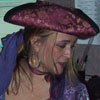 |
| Ireland 2007--Mona |
Monasterboice is now just a cemetery but it has a long history. Founded first in the 4th century by St Buite who died in 521, it has seen many incarnations. It laso had significance to Mellifont Abbey. The tower and the High Crosses date from the tenth century though the tower might be even older. The original abbey is long gone but there are remains of two 14th century abbeys. Over a thousand years of use here and there is still significant detail left. I can only imagine how majestic these crosses were in their virgin state. I did not know before that the reason there is the round circle on the crosses is that the versions made of gold and jewels would start to bend under the weight of the design and the circle was a support structure to hold up the arms of the cross.
The tower, it is believed, was used for protection when the Vikings came by. It is still over 100 feet high and no longer complete. As well, over time, dirt has built up around the base and the once elevated doorway is now about 6-8 feet above ground. Of course this would have been used for storage and for a lookout as well.
Monasterboice was our last stop around the Newgrange area. It wasn't far from the towns of Drogheda, Tara or Slaine.(Pronounced Droda but you'd hear different pronunciations depending on whether the person was saying the Gaelic or the English version.)
We never did get any pictures of Slaine (two weddings booked in the castle and there after dark for dinner the second night), and though we drove through Kells the night before it was too late for the tourist center. As it was now Sunday we would have had to hang around till 2 pm to get in and as it turns out, there are two Kells in Ireland. The other is in the southwest and neither house the Book of Kells, which I regret not seeing.
By this time we were getting a better sense of driving about and learning to just stop and ask directions, especially when we'd be at a corner that had signs pointing east and south at the same time. Signs for touristy things (landmarks, historic sites, beaches) were in brown and helped a lot in finding places. Towns were in white (w/black lettering) or green (w/white lettering). It seems the secondary routes were the white signs. The roundabouts, on the other hand, never really did get easy.
Next, Belfast to Ballycastle.

No comments:
Post a Comment